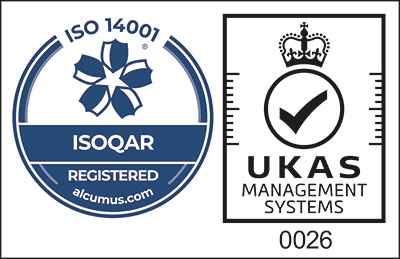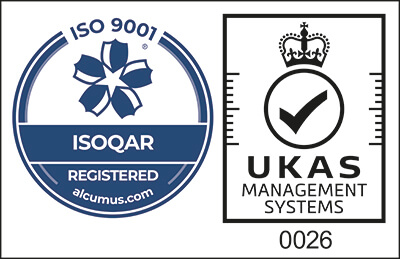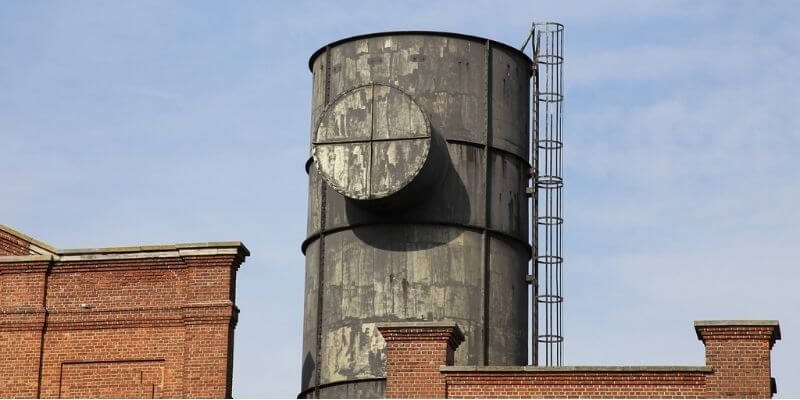
Want to know everything there is about water tank cleaning? You’ve come to the right place!
Adequate and high-quality water storage is essential for preserving the water used for distribution networks, domestic and commercial purposes. Even more so if the water you store is potable.
The condition of your water tank is impacted by many external forces, so cleaning your water tank is essential to ensure your water supply is still suitable for use.
Our detailed guide features information on how to clean a water tank, the importance of regular cleaning and the benefits of hiring a professional for the task.
How to Clean a Water Tank – Step by Step
So how to clean a water tank? Cleaning your water tank is a fairly simple process, however, do ensure that whoever is doing it is trained and has the correct cleaning equipment for the task.
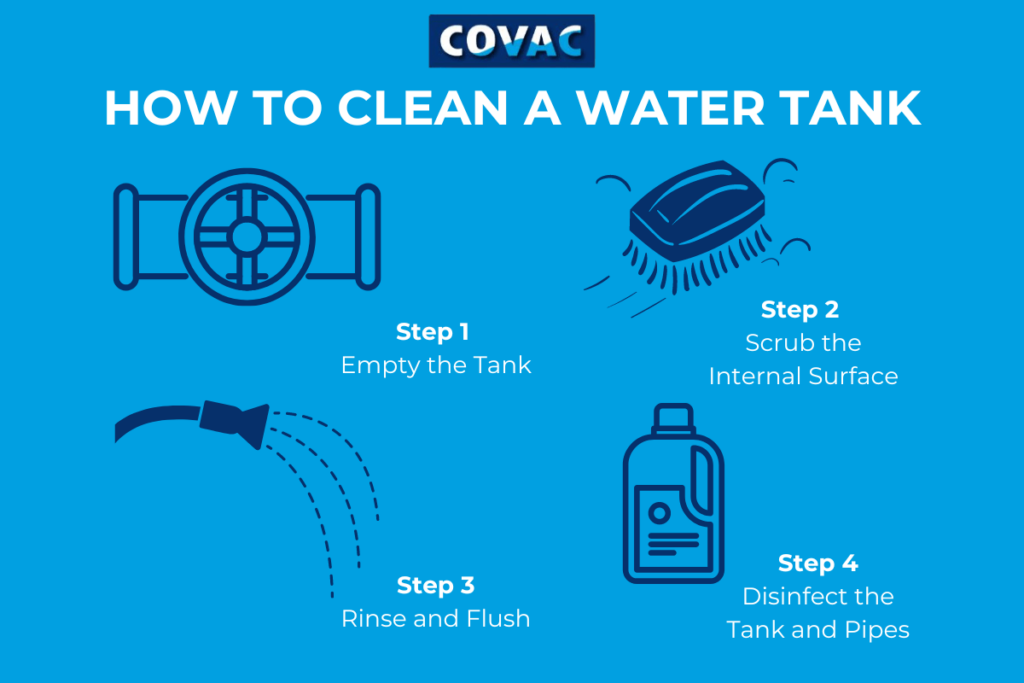
There are a few things to consider when conducting your water tank maintenance procedures. These are:
- The size of your tank
- What equipment you have available
- Your overall knowledge of water tanks
If you have a standard/small barrel sized tan, and simply require dirt and grime to be removed, you can most likely get away with washing the barrel down with a quick garden hose.
However, on the flip side, if you suspect that harmful bacteria could be present in your water tank, you might need specialised equipment and knowledge to get rid of it.
In general, your tank should be cleaned bi-yearly to ensure the risk of bacteria forming inside it is minimal.
When cleaning a water tank you should follow these steps:
Step 1 – Empty the Tank
The first thing you need to do is drain your water tank so you can get inside to perform an effective cleaning. To do so, shut off the valve to the distribution line and open the outlet valve to drain out as much water as you can.
Step 2 – Scrub the Internal Surface of the Tank
Once water has been drained, you can use a mixture of detergent or bleach and hot water. Depending on the size and accessibility of your water tank, you can use a brush or a high-pressure jet to scrub the internal surface. Make sure to get every corner and crevice to prevent bacteria from remaining in those small gaps.
Allow the mixture to sit for at least two hours.
Please note that the internal cleaning of your water tank should be carried out by qualified individuals and only while wearing appropriate equipment.
Step 3 – Rinse and Flush
Once the mixture has done its job at killing any bacteria, it’s time to rinse your tank with clean water. A high-pressure hose or water jet is best for this task. Keep rinsing until clear water starts running from the outlet.
If you don’t have the suitable equipment, you can fill your water tank with water (preferably hot) and leave it to sit for a few hours. Afterwards, drain the water out and collect it for safe disposal.
Step 4 – Disinfect the Tank and Pipes
For this step it’s most effective to use an anti-bacterial spray or liquid bleach. The general rule if using bleach is to put 5ml for every litre of your water tank.
To disinfect your tank you need to open the valve to the distribution line and run water out of all taps until you can smell bleach in the water. This ensures that all pipes and taps are sterlied and free of bacteria. Allow the bleach to sit for at least four hours before emptying the tank again and flushing the entire system again.
The whole cleaning process involves working in confined spaces which can be dangerous. If you don’t have the necessary knowledge or equipment, we do not recommend that you clean your water tank yourself. To prevent any accidents, always call out a professional when it’s time to clean your water tank.
Why is Water Tank Cleaning Important?
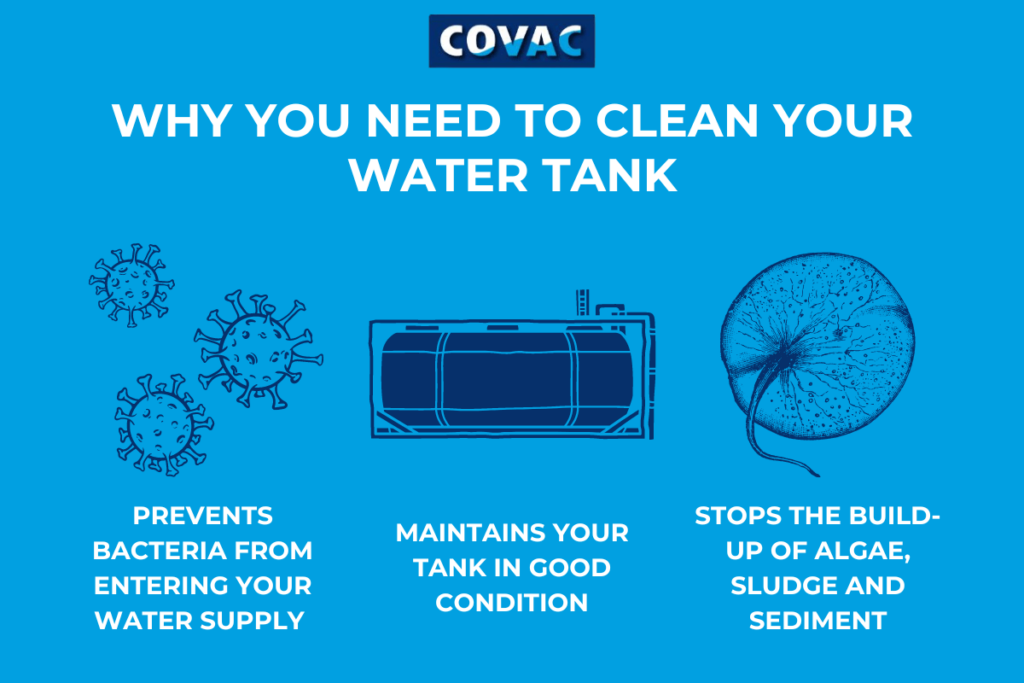
There are a number of reasons why cleaning your water tank is important. Not only for the water in storage, but also for the state of your tank itself.
Water storage tanks are found in a large number of modern settings, from businesses to hospitals, educational facilities and more.
With age any water tank becomes susceptible to corrosion which is often difficult to identify. The damage can present itself as microcracks that allow bacteria and mould to get into your tank.
Algae, sludge and sediment build-up also encourages the breeding of bacteria in your tank, providing it with nourishment. The accumulation of these elements combined with a lack of regular water tank cleaning, can begin to affect the internal components of your system.
This can lead to the development of unpleasant smells and tastes causing extreme sickness if left for too long.
While water tank cleaning doesn’t prevent the occurrence of natural deterioration, it prevents bacteria from multiplying and nullifying your water supply.
A Side Effect On Drinking Contaminated Water
Legionnaires’ Disease
One of the severe effects of drinking contaminated water is Legionnaires’ disease. Although relatively uncommon, this illness can be very dangerous.
Hospitalisation is often necessary due to the infection attacking the lungs, with patients often having to use alternative breathing methods. Treatments for Legionnaires’ disease involve antibiotics inserted directly into a vein. This can last between one and three weeks.
What Are The Symptoms of Legionnaires’ Disease?
Symptoms of Legionnaires’ disease include difficulty breathing, coughing, fever and chest pain, as well as common flu-like symptoms. People experiencing these symptoms are advised by the NHS to contact 111. For further information regarding the HSE’s recommendations on the prevention of Legionnaires’ disease, click here.
Why Should You Hire a Professional Tank Cleaning Company?
Resources and Equipment
As previously mentioned, your tank cleaning process can be quite alien, if you do not know what you are doing. For this reason alone, you should always hire a professional. Someone with experience will have the appropriate equipment and knowledge to perform the task more efficiently.
Health and Safety
Another reason to hire a professional to conduct your water tank maintenance is health and safety considerations. Water tanks are often large in size or can even be in an elevated location. As such, you may need to have extendable ladders and experience dealing with heightened areas.
In some cases, the water tank cleaning process may involve a ‘full tank’ drainage procedure. And in extreme cases even a process known as ‘desludging’. This can only be conducted by a professional as you will need to safely transport the contents/sludge so it does not contaminate with the rest of the environment.
How Can COVAC Help Keep Your Water Tank Clean?
Of course, keeping your water tank clean is one of the most efficient ways of protection against harmful bacteria. However, it’s not the only thing you can do.
Our Acothane DW Coating
Here at COVAC we install water tank lining made using Acothane DW coating designed for optimum protection.
Our coatings provide a guard against corrosion inside your water tank, which could lead to significant damage to your system
Repairs and Refurbishment
As well as lining we provide water tank repairs and refurbishment that combat the effects of damage inside your water tanks. This eliminates the need for a full tank replacement before its time and saves you money in the process.
To inquire about our coating system or any other services, please don’t hesitate to contact our team.
Speak With Our Team
Need an expert’s help with your water storage tank maintenance? Our team is always happy to help.
Get in touch today!
Where to Find Us





